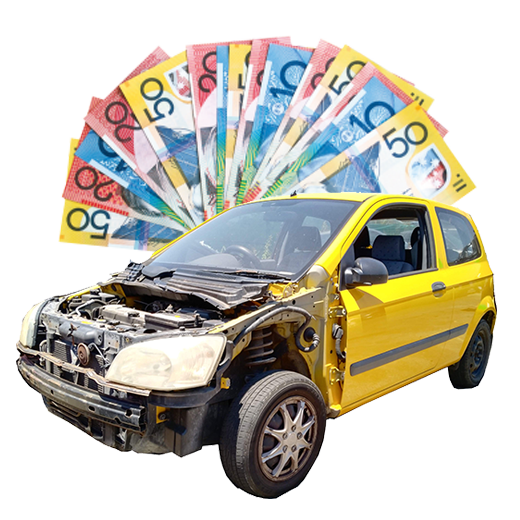Before we get into the nuts and bolts of how to recycle your engine oil, it's worth taking a moment to understand why it’s so critical. Tipping old oil down the drain or dumping it on the ground might seem like a quick fix, but it causes huge environmental headaches.
A single litre of used oil can contaminate up to one million litres of fresh water. That’s a staggering amount, and it’s a statistic that really hits home when you think about our local rivers and groundwater.
Why You Should Never Pour Oil Down the Drain
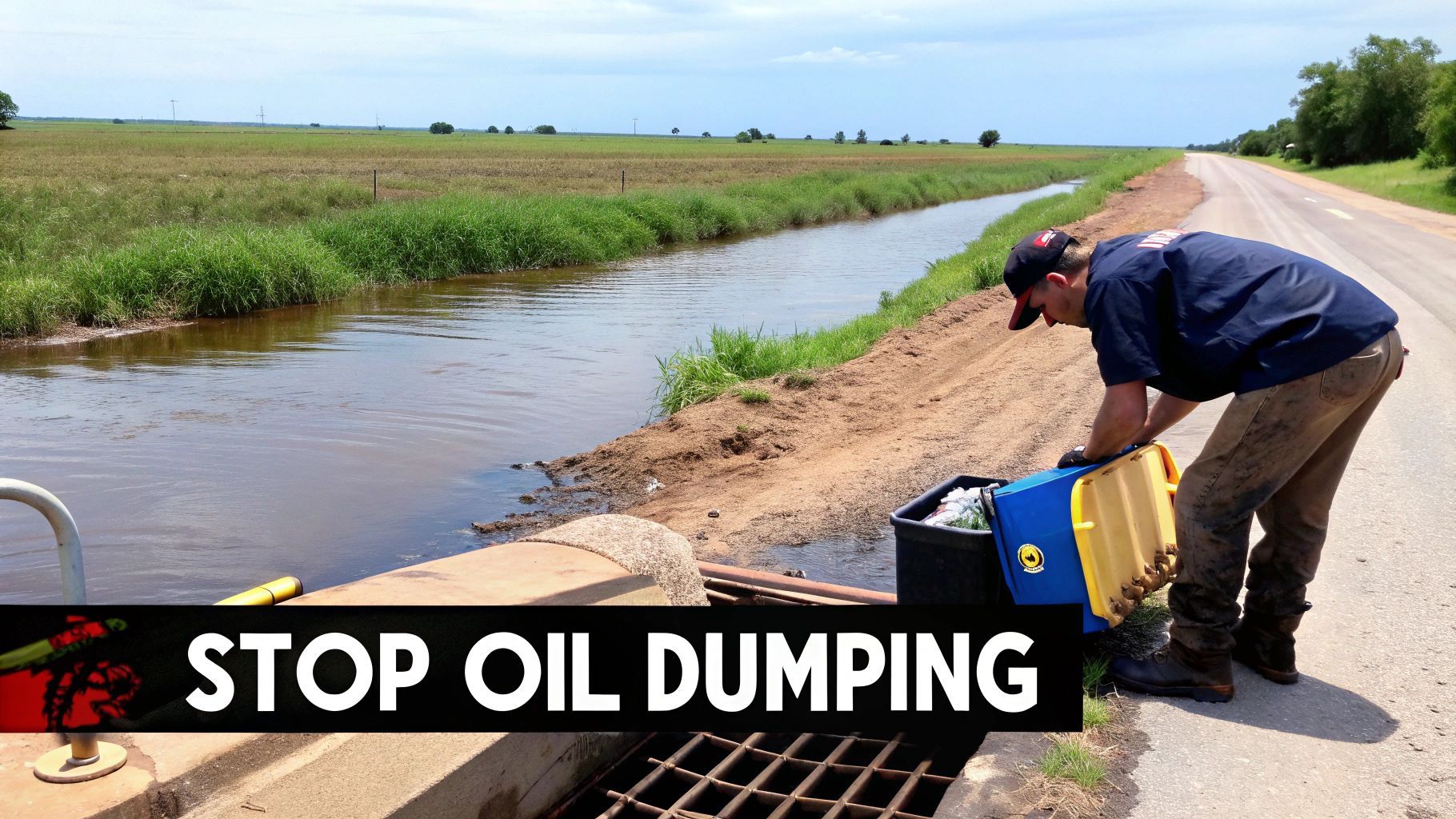
It’s easy to underestimate the impact of one person changing their car’s oil. But when you add up all the DIY mechanics across Australia, improperly dumped engine oil becomes one of the biggest sources of pollution in our waterways. This isn't just an abstract warning; it has a direct effect on our local ecosystems, from the Adelaide Hills right down to our coastlines.
The sheer volume of waste oil generated by home mechanics is surprisingly high. When this stuff isn't recycled, we're missing a massive opportunity to recover a valuable resource.
The Hidden Value in Used Oil
Used engine oil doesn't just "go bad." It simply gets loaded up with tiny particles and contaminants from doing its job inside your engine. The base oil itself is still incredibly valuable and can be cleaned up and used again.
The re-refining process is quite clever and involves a few key stages:
- Filtration: First, all the solid gunk is removed, like tiny metal shavings and sludge.
- De-watering: Next, any water that has mixed with the oil is separated out.
- Re-refining: This is the core part, where a complex process strips away the old additives and impurities. What’s left is a high-quality base oil, ready for a new life.
This re-refined oil can then be blended with fresh additives to make brand-new lubricants, hydraulic fluids, and other industrial products. So, recycling isn't just about avoiding a mess; it's about closing the loop and conserving a finite resource. If you're looking for more details, you can explore some extra safe tips for disposing of motor oil in Australia.
By choosing to recycle, you're not just preventing pollution. You are actively contributing to a system that reduces our reliance on crude oil extraction and saves significant energy.
Australia's Recycling Landscape
The scale of this opportunity in Australia is immense. Each year, we generate around 350 million litres of waste lubricant oil. Shockingly, about 60% of that is simply burned for energy, and another 24% is exported for the same reason. This not only contributes to greenhouse gas emissions but also wastes a perfectly good resource.
Thankfully, initiatives like the Northern Oil Refinery are tackling this head-on, working to re-refine that waste oil back into high-quality base oils right here in Australia. It's a smart move that benefits both the environment and our economy.
Setting Up for a Clean and Safe Oil Change
A successful oil change—and a successful recycling effort—begins well before you even get a spanner near the sump plug. Trust me, getting your setup right from the start is the key to a clean, spill-free job. If you rush this part, you’re almost guaranteed a greasy mess on your garage floor and contaminated oil that recycling centres will reject.
Your most important piece of kit is a proper drain pan. I know it’s tempting to grab an old bucket, but a purpose-built pan is wide and low, designed to catch that initial torrent of oil without splashing it everywhere. Most have a handy spout for pouring, which makes life a lot easier later on. It’s a small investment that pays for itself with every oil change.
Once the old oil is drained, you'll need a clean, leak-proof container with a secure lid to store and transport it. Honestly, the best container is usually the one you just emptied. The original oil bottle is designed for the job, has a tight seal, and is already labelled. Whatever you do, don't use old containers that once held things like coolant, bleach, or other chemicals—that’s a surefire way to contaminate the oil.
Essential Tools for a Clean Job
Beyond the pan and bottle, a few other items will make the whole process much smoother and safer. These aren't optional if you want to do the job properly.
- Nitrile Gloves: Used engine oil is full of nasty contaminants you don’t want on your skin. A decent pair of nitrile gloves will keep your hands clean and protected.
- Funnel: A clean, wide-mouthed funnel is your best friend when it’s time to pour the oil from the drain pan into your storage container. It’s the difference between a clean transfer and a frustrating spill.
- Old Rags or Cardboard: Always have a stack of old rags or a big piece of cardboard ready. Lay it down under your work area before you start—it will catch any drips you didn't see coming.
This infographic gives a great visual breakdown of the gear you'll want to have on hand.
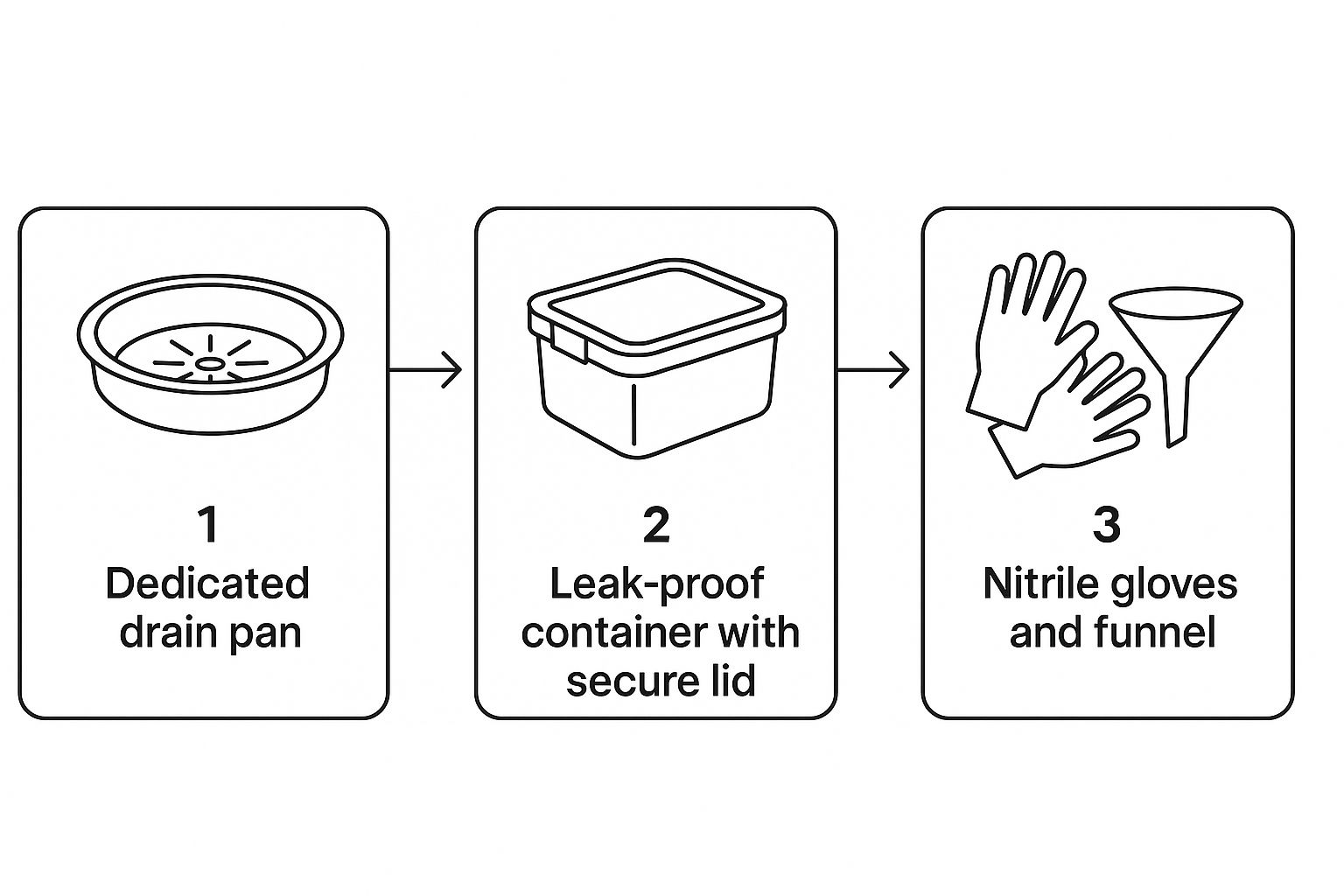
Having all the right tools ready to go makes the entire process of how to recycle engine oil simpler and far more efficient.
Draining and Collecting Your Used Oil the Right Way
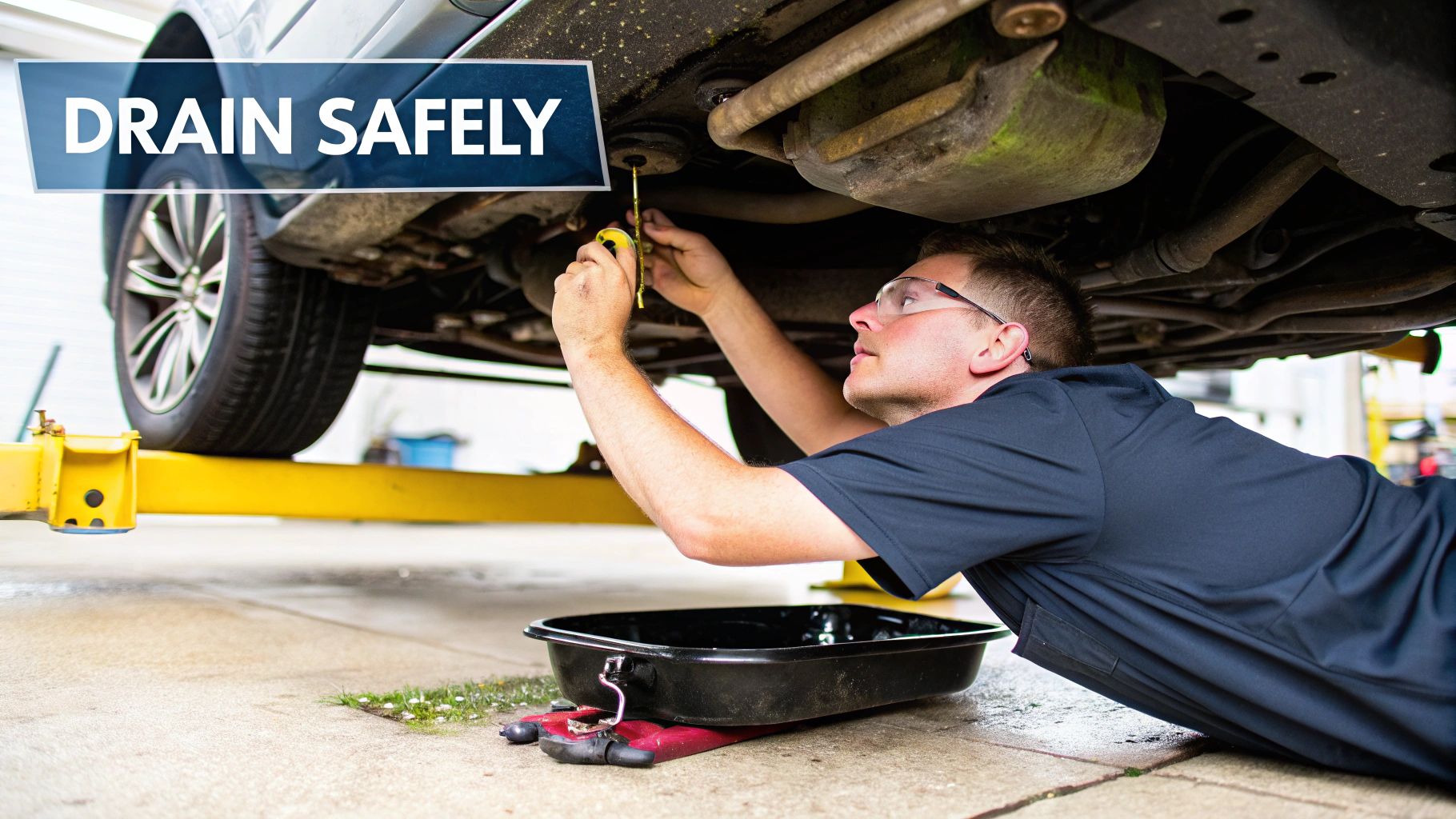
Alright, with your gear sorted, it's time to get that old oil out of the engine. The secret to a clean, hassle-free drain is all in the prep work. Here's a pro tip: run your engine for a couple of minutes before you start. This warms up the oil just enough, making it thinner so it flows out faster and more completely.
You don't want the engine scorching hot, mind you—just warm enough to get things moving.
Slide your drain pan directly under the sump plug. This sounds simple, but you'd be surprised how many people misjudge the initial gush of oil, ending up with a slick mess on their driveway. I always place the pan slightly rearward of the plug, because the oil will shoot out at an angle at first.
The Drain and Collection Process
When you're all set, carefully loosen the sump plug with the right-sized spanner. For those final few turns, switch to doing it by hand. This gives you way more control and helps you avoid the classic blunder of dropping the plug into a pan full of hot, sludgy oil. We’ve all been there. As you feel the threads disengage, pull it away quickly.
Now, just let it drain. This can take a good five to ten minutes, so be patient and let gravity do its thing. While that's happening, you can get started on the oil filter.
Your old oil filter is also full of dirty oil and needs to be handled with care. Grab an oil filter wrench to loosen it, and make sure your drain pan is positioned underneath to catch the drips. Once it’s off, flip it upside down over the pan and let it drain for at least 15-20 minutes. Most collection facilities will happily take the old filter along with the oil since the metal casing is also recyclable.
Why Avoiding Contamination is Everything
This is probably the single most important part of the whole process: keep the oil pure. If you mix any other fluids in with your used engine oil, you can contaminate the whole lot, making it completely unsuitable for recycling.
Think of it this way: recycling facilities re-refine used oil to give it a new life. Even a tiny amount of coolant, brake fluid, or solvent can spoil the entire batch, potentially ruining hundreds of litres of oil.
To make sure your oil is accepted, stick to these ground rules:
- One Fluid Only: Never, ever mix anything else into your used oil container. That means no antifreeze, no brake or transmission fluid, and definitely no petrol or solvents.
- Keep Your Gear Clean: Give your drain pan, funnel, and storage container a quick wipe to ensure they're free from other chemical residues before you begin.
- Separate and Label: If you're draining other vehicle fluids, use completely different and clearly labelled containers for each one. Don't risk a mix-up.
By focusing on a clean collection, you’re guaranteeing your efforts aren't for nothing. You’re not just getting rid of waste; you're creating a valuable resource, and that's what recycling engine oil is all about.
Storing and Transporting Your Used Oil the Right Way
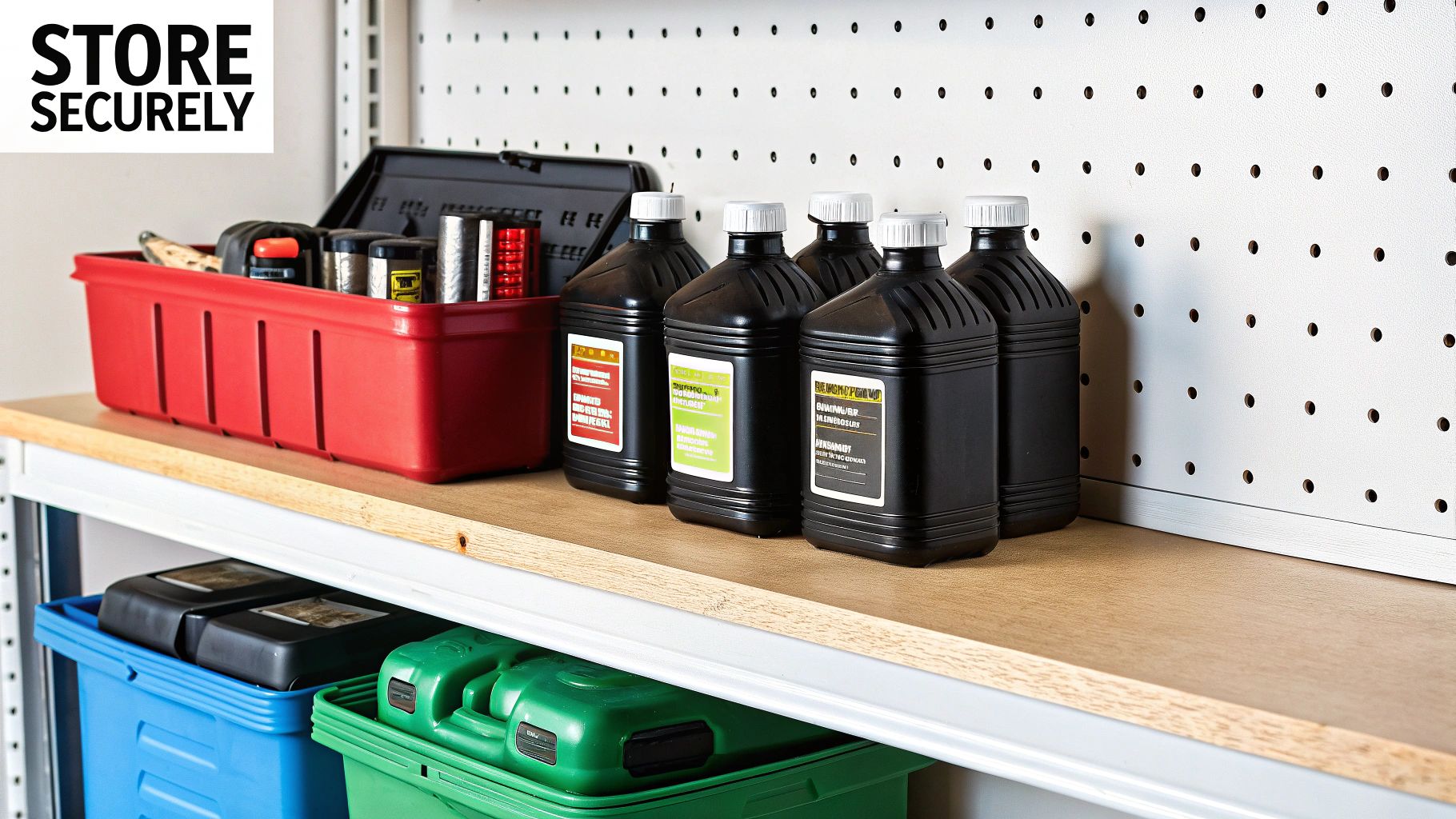
Alright, so the old oil is drained and sitting in your pan. Don't call it a day just yet—handling it properly from here is what makes recycling possible. The next step is getting it into the right container.
Honestly, the best container is usually the one the new oil came in. It’s purpose-built, has a solid screw-on cap, and you know it’s clean. Just pour the fresh oil into your engine, then use a funnel to get the old stuff back into the empty bottle. Simple.
Whatever you do, don't reach for an old soft drink bottle or a container that once held bleach, pesticides, or even coolant. The leftover residue from those products will instantly contaminate the oil, and the recycling centre will have to reject it.
Keeping It Safe Until Drop-Off
Once you've got the used oil in a sealed container, you need to store it somewhere sensible until you're ready to head out. A cool, dry spot on a garage shelf or in the corner of a shed is perfect, just make sure it's out of reach of kids and pets.
I always recommend placing the sealed bottle inside a larger tub or on an old tray. It's a cheap and easy way to catch any potential drips and save yourself from a messy cleanup later.
Then, grab a permanent marker and clearly label the container "Used Engine Oil". This small action prevents any mix-ups and is a core part of learning how to dispose of motor oil safely in Australia.
A quick tip from experience: always double-check the lid. A loose cap can lead to a slow leak, creating a nasty, slippery mess on your garage floor. Make sure it's on tight before you walk away.
Getting It to the Recycling Centre Without a Spill
When it's time to take your oil for recycling, the last thing you want is for it to tip over in the back of your car. I've heard a few horror stories.
The best way to prevent a disaster is to secure the container. Wedge it upright in a corner of your boot, or better yet, place it inside a sturdy cardboard box or a milk crate so it can't slide or topple over when you take a corner. A little bit of care here ensures you and your oil arrive safely.
Here's a handy checklist to run through before you head out. Following these simple points makes the whole process smooth and spill-free.
Safe Storage and Transport Checklist
| Checklist Item | Why It Matters | Pro Tip |
|---|---|---|
| Use a Proper Container | Prevents leaks and contamination. The wrong plastic can degrade. | Reuse the original engine oil bottle. It's designed for the job. |
| Label It Clearly | Avoids accidental misuse or incorrect disposal by someone else. | A simple piece of masking tape and a permanent marker is all you need. |
| Tighten the Lid | A loose cap is the number one cause of messy and hazardous spills. | Give it an extra turn by hand to be certain it's completely sealed. |
| Store in a Safe Place | Keeps it away from heat, moisture, children, and pets. | A high shelf in a locked garage or shed is an ideal spot. |
| Use a Drip Tray | Provides secondary containment for any unexpected minor leaks. | Old baking trays or shallow plastic storage tubs work perfectly. |
| Secure During Transport | Stops the container from tipping over and spilling oil in your vehicle. | Place it in a box and wedge it against the side of your boot. |
Getting these small details right not only keeps your space clean but also guarantees the oil you’ve collected can have a second life through recycling.
Finding a Used Oil Drop-Off Point in Australia
https://www.youtube.com/embed/xfIejLUNhaU
Alright, you’ve done the hard part – the oil is drained, collected, and safely stored away. Now for the final, crucial step: getting it to a proper recycling facility. Thankfully, Australia has a pretty solid network of drop-off points, so doing the right thing is easier than you might think. You just need to know where to look.
My first stop is always the local council's website. Most councils run resource recovery centres or waste transfer stations that take used engine oil from residents, and it's usually free. A quick search for "used oil disposal" on their site should give you everything you need – addresses, opening hours, and any specific rules they might have.
Common Drop-Off Locations
Beyond the council depot, plenty of local businesses have stepped up to help out. This makes the whole process incredibly convenient for most of us.
- Auto Parts Retailers: Big names like Supercheap Auto and Repco often have dedicated collection tanks. It's a fantastic service, especially if you're already there picking up new supplies.
- Mechanic Workshops: Your local mechanic or service centre might take used oil off your hands, particularly if you're a regular customer. It never hurts to ask.
- Online Locators: Websites like RecyclingNearYou.com.au are brilliant. Just pop in "used oil" and your postcode, and it'll show you a map of the closest collection points.
Here's a tip from experience: always make a quick phone call before you head out. Just confirm they accept oil from the public, check their hours, and ask about any limits on how much you can bring – most places have a 20-litre cap per visit. A two-minute call can save you a completely wasted trip.
The Bigger Picture of Australian Oil Recycling
When you drop off that container of old oil, you're plugging into a nationwide system that's all about creating a circular economy. Companies across Australia play a vital role in this.
Specialists like Global Resource Recovery and Summerland Environmental are key players, collecting and sending used oil to re-refining plants. These facilities operate under strict environmental standards, turning that waste back into clean, high-quality lubricants.
For more localised advice, you might be interested in our guide on where to dispose of motor oil in Australia. Knowing your options makes finishing the job simple and effective.
Still Have a Few Questions?
Even if you’ve got the process down pat, a few questions might pop up when you’re dealing with used engine oil. It’s completely normal. Let’s tackle some of the most common queries I hear, so you can handle your next oil change with total confidence.
Can I Mix Different Kinds of Oil?
This is a big one. The short answer is yes, you can absolutely pour your used synthetic and mineral oils into the same collection container. They’re all headed for the same recycling process.
The golden rule, however, is to never mix in other automotive fluids. Things like coolant, brake fluid, transmission fluid, or solvents are a definite no-go. This kind of cross-contamination can ruin the entire batch, making it unrecyclable. Keep it pure.
How Much Can I Drop Off at Once?
Most council depots and auto parts stores that accept used oil have a limit. Generally, you can expect to drop off up to 20 litres per visit.
That said, it’s always a good idea to give them a quick call before you head over, especially if you have a bit more than that. A two-minute phone call can save you a wasted trip.
What if I Spill Some Oil?
It happens. If you accidentally splash some oil on the driveway, the worst thing you can do is hose it down the drain. Instead, grab some kitty litter, sand, or even sawdust and cover the spill completely.
Let it sit for a few hours to absorb all the oil, then simply sweep it up, bag it, and toss it in your general rubbish bin.
What about the empty plastic oil bottle? Once you've drained all the old oil out, the container itself can usually go straight into your household recycling bin. Just double-check your local council’s rules to be sure.
Let's be honest, not everyone in Australia is a pro at DIY oil changes just yet. Recent stats show there's still a learning curve, but the push from auto retailers to offer easy drop-off points is making a huge difference. You can dive deeper into these Aussie oil change statistics and trends to see how things are improving.
Every time you recycle your oil correctly, you’re doing your bit to protect our local environment. It's a small act that adds up to a massive positive impact.

